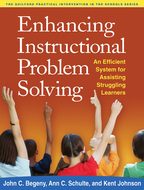Enhancing Instructional Problem Solving
An Efficient System for Assisting Struggling Learners
John C. Begeny, Ann C. Schulte, and Kent Johnson
1. Introduction to the Systems-Oriented Plan for Academic Achievement
2. SOPAA Key Definitions, History, Components, and Roles
3. Preliminary Considerations for SOPAA Implementation
II. The Six SOPAA Components
4. Initial Steps of the TAPS Process: Requests for Academic Support and Preparation for the Intervention Planning Meeting
5. Secondary Steps of the TAPS Process: Intervention Planning, Follow-Ups, and Summative Reviews of Intervention Effectiveness
6. Assessment for Instruction
7. Maximizing Implementation through Targeted Professional Development
8. Maximizing Intervention Delivery through Recruiting and Training School Volunteers
9. Obtaining Support for the SOPAA through Effective Communication with School Leaders
10. Obtaining and Sustaining Support for the SOPAA through Effective Communication with Teachers
11. Using the SOPAA with Multidisciplinary Co-Facilitators
III. Additional Information and Guidance
12. Evidence-Based and Learner-Verified Intervention Programs in Reading, Mathematics, and Writing
13. Case Illustrations of SOPAA Implementation
14. Using the SOPAA to Support Graduate Students’ Training and Applied Experiences in Schools
Epilogue
Appendices



